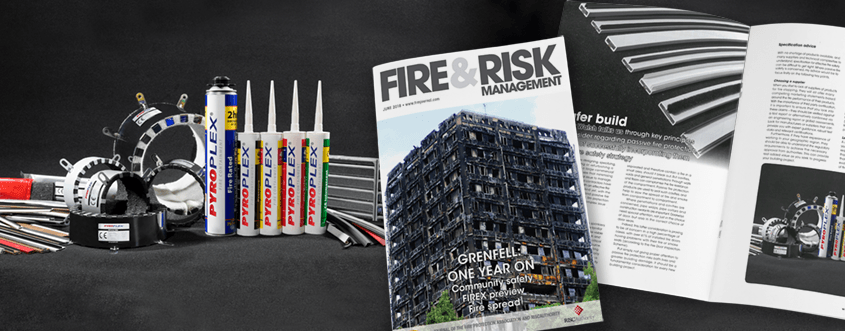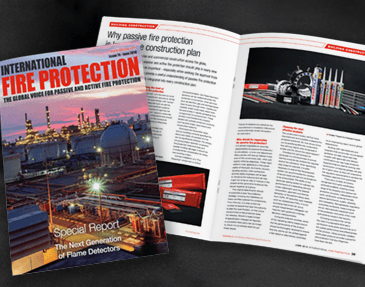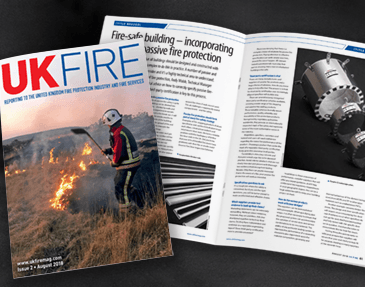 When designing, specifying, constructing or refurbishing a building or large commercial structure, it’s clear to see that minimising the risk of fire is a critical issue to manage. Architects, specifiers and contractors have a responsibility to build with an effective fire safety strategy in mind. And yet, with the available types of active and passive fire products to be considered, fire protection is a highly technical and complex issue to comprehend.
When designing, specifying, constructing or refurbishing a building or large commercial structure, it’s clear to see that minimising the risk of fire is a critical issue to manage. Architects, specifiers and contractors have a responsibility to build with an effective fire safety strategy in mind. And yet, with the available types of active and passive fire products to be considered, fire protection is a highly technical and complex issue to comprehend.
Andy Walsh is Technical Manager at Pyroplex Ltd, the UK’s leading manufacturer of passive fire containment systems. He talks us through some of the key principles to consider where passive fire protection is concerned, ahead of successfully incorporating such components into a fire safety strategy for a safer build.
Passive fire protection and its role in fire safety

Passive fire protection is about dividing a building into compartments – usually determined by floors and walls. The aim is to ensure that these compartments are fully separated and therefore contain a fire in a small area, should it break out. But cavities, voids and general penetrations through walls and floors can compromise the fire resistance of the compartment. Passive fire protection products are used to seal such cavities and help to slow the spread of fire and smoke from compartment to compartment.
Where penetrations and cavities are concerned, pipe wraps, pipe collars and construction sealants are important. Doorways need special attention, not just in the choice of door, but in the correct choice of door seals. This latter consideration is proving to be concern in a high percentage of cases, with over 61% of installed fire doors having problems with their fire or smoke seals (source: Fire Door Inspection Scheme).
Put simply, not giving proper attention to passive fire protection risks both lives and greater building damage. It should be a fundamental consideration for every new building project.
Specification advice
With no shortage of products available, many suppliers and technical complexities to understand, specification for effective fire safety can be a tough job to get right. Where passive fire safety is concerned, my advice would be to firstly focus on the following key points.
- What to look for in a supplier
When you start to look at suppliers of fire stopping products, they will all offer many compelling marketing statements based around the fire performance of their products. With the importance of Third Party Certification, ensure that you interrogate these claims – they should be verified against a test report or alternatively confirmed via an engineering report or global assessments.
Look for manufacturers or suppliers that can provide you with expert guidance, robust test data and relevant certifications. Furthermore, if they have experience of working in your geographic region, they should be able to understand the regulatory requirements to achieve the necessary approval from authorities. This can provide real added value as you seek to progress your building project.
- Understand how the various products can work with your designs
Choosing the right passive fire product (or products) is a critical process, to ensure that the outcome can achieve the required level of fire resistance. When specifying pipe wraps for example, it is often necessary to ensure that the proposed system can accommodate the variation of service sizes and service combinations to be encountered.
The ability of any particular sealing system to maintain the performance of a separating element is also dependent upon the material composition, geometry and thermal behaviour of the element being used, from HDPE, PP and other pipe materials such as unplasticised PVCu.
When it comes to fire doors, manufacturers should be able to offer fire door seals that have been specifically paired and fully tested with their doorsets.
- What level of fire resistance do you need?
A competent supplier should be able to help you with this question and understand the regulatory requirements that you need to meet. It’s critical that you are clear on the requirement and that you have access to independent test evidence to demonstrate the correct level of fire resistance for each component.
Why certification and traceability are essential

The fundamental benefit of any Third Party scheme is focused around giving the regulator, specifier, customer and end-user confidence regarding the stated performance of the product, providing an informed choice when purchasing or selecting such components. Choosing a product that carries the mark of a reputable Third Party Certification body gives assurances as to the overall performance and effectiveness of that product.
Maintaining full traceability for all fire stopping components should be standard practice and it is something that Pyroplex strongly advocates and supports. Avoid inferior products that are not clearly branded and proven with thorough test evidence from recognised testing houses. Only then can you be reassured that in the event of a fire, your passive fire protection will work as intended.
Don’t overlook installation

Where to seek further help and advice
Understandably, everyone in the construction industry cannot be an expert on passive fire protection and have relevant, region-specific knowledge to assist in an effective outcome. It is important therefore, to work closely with specialist organisations, manufacturers and suppliers that can offer that service to you. In doing so, you will be able to develop a strategy that will meet the approval of the authorities first time and minimise delays due to unforeseen problems during the build. Plus, the completed building will be equipped to slow the spread of fire, leading to a safe evacuation and less costly damage.
- ASDMA
ASDMA (Architectural and Specialist Door Manufacturers’ Association) acts as a knowledge centre for the benefit of both members and the wider industry when it comes to timber fire doors and seals. With direct influence on UK, European and international standards, ASDMA educates and promotes best practice amongst specifiers, fabricators and installers on many critical and complex technical issues. It offers a huge knowledge and contact base to those organisations that need to work through the technicalities of specifying and installing timber fire doors for optimum results.
- ASFP

- BWF
The British Woodworking Federation is responsible for the award-winning awareness campaign, Fire Door Safety Week. The Federation can supply invaluable resources such as the BWF-Certifire Installation Guide.
- Specialist manufacturers
Talking face-to-face with specialist manufacturers about their products and the issue of passive fire safety as a whole can be hugely beneficial when wishing to gain further advice and help. The upcoming Firex International exhibition (Excel London, 19th to 21st June 2018) is an excellent opportunity to do just that and learn more about passive fire safety first-hand. Should you wish to meet Pyroplex, you can find us on stand A410. The exhibition promotes third-party approved fire safety products and welcomes over 17,000 fire professionals from across the globe to share best practice and remain up to date on changes in legislation.
- Fire-safe building - 21st August 2018
- How to incorporate certified passive fire protection for a safer build - 18th June 2018
- Why Passive Fire Protection is Key to the Construction Plan - 12th June 2018



